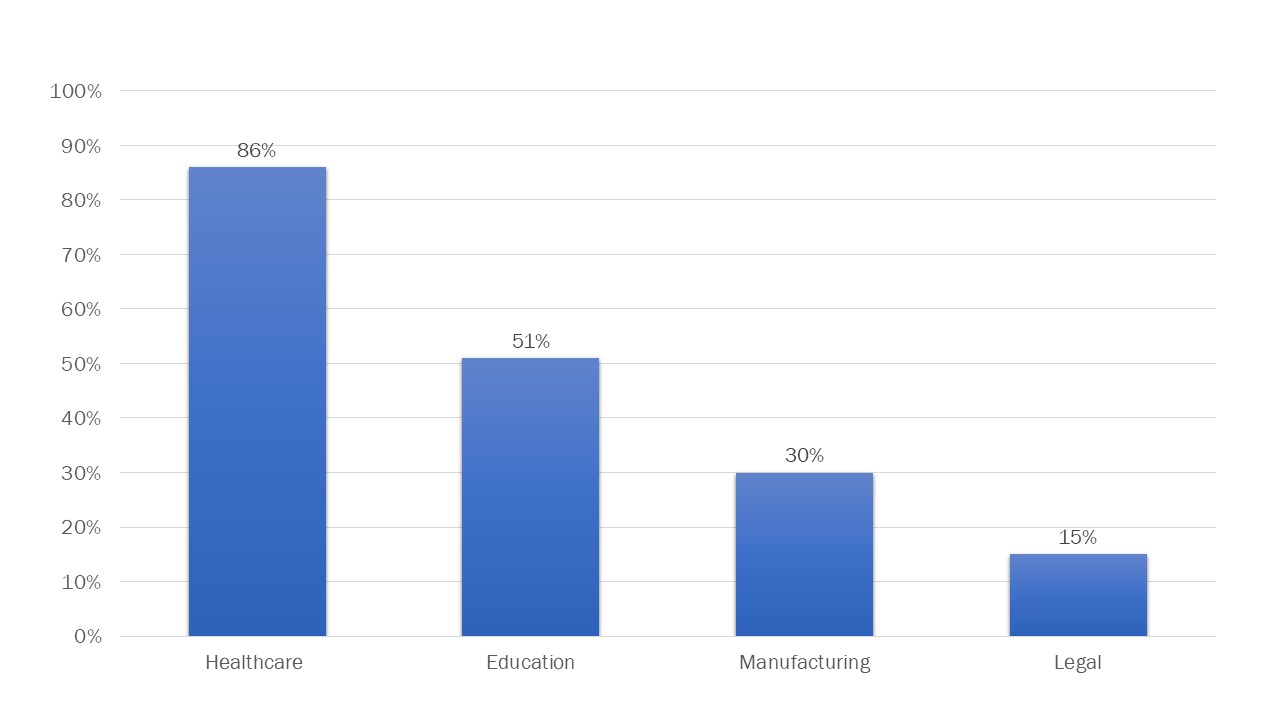How AI is Reshaping Industries While Navigating a Minefield of Challenges
- Generative AI Adoption: Who’s Leading the Charge?
The adoption of generative AI varies significantly across industries, with some sectors embracing the technology rapidly while others proceed cautiously due to regulatory, ethical, or operational challenges. Healthcare leads the way, with an estimated 86% of providers, life science firms, and tech vendors now leveraging AI in some capacity. Generative AI is transforming medical documentation, drug discovery, and patient care, enabling faster diagnoses and reducing administrative burdens. Despite its potential, challenges such as data privacy and regulatory compliance persist, slowing deeper integration into sensitive clinical workflows.
Education reflects a surge in adoption, with 51% of teachers reporting use of ChatGPT within just two months of its launch, and 40% relying on it weekly. Educators are deploying generative AI for personalized learning, automated feedback, and content creation, though concerns about academic integrity and over-reliance on automation temper its broader institutional acceptance.
Manufacturing shows measured progress, with ~30% of companies piloting or deploying generative AI, according to McKinsey. Applications such as predictive maintenance, product design optimization, and supply chain automation are driving efficiency gains. However, adoption is constrained by high implementation costs and the need for workforce upskilling.
The legal sector lags furthest behind, with only 15% of small firms and 3.7% of solo practitioners actively using or exploring AI tools. While generative AI holds promise for contract analysis, legal research, and drafting, adoption is hindered by skepticism about accuracy, ethical concerns, and the traditionally risk-averse nature of the industry.
To explore deeper insights and industry trends, visit: https://www.databridgemarketresearch.com/reports/global-generative-ai-market for the latest Generative AI Market Research Report, featuring key developments, market forecasts, and strategic opportunities shaping the future of AI-driven innovation
2. Content Creation: Speed vs. Accuracy
Generative AI has revolutionized content creation, enabling businesses to scale content production exponentially. Companies can now generate blogs, social media posts, and marketing materials in seconds, saving time and resources. However, this rapid generation comes with trade-offs, particularly in terms of accuracy and reliability. AI-generated content can sometimes contain factual inaccuracies, biases, or misleading information, making human oversight crucial.
- News Articles: AI-generated content has a 12% error rate, significantly higher than the 2% human error rate. This raises concerns about misinformation and credibility, especially in journalism
- Code Generation: AI produces 40% more vulnerabilities compared to human developers, posing potential cybersecurity risks if not thoroughly reviewed
- Marketing Copy: AI-generated copy has an 8% error rate, but its ability to create 100x more content variations in minutes outweighs this limitation for many businesses seeking scalability
Beyond content creation, AI is driving major efficiency improvements in other industries. For instance, the healthcare industry is experiencing a 70% faster drug discovery rate by leveraging AI, machine learning, and computational biology. These advancements accelerate target identification, molecular modeling, and clinical trial optimization. Meanwhile, manufacturing reports 25–40% efficiency gains, thanks to automation, predictive maintenance, and real-time data analytics that streamline production, reduce waste, and enhance overall operational performance.
3. Automation’s Double-Edged Sword: Job Loss vs. Innovation
The rise of AI-driven automation is transforming job markets across multiple industries. By 2030, AI is expected to disrupt workforces, eliminating some roles while creating entirely new ones. While automation improves efficiency and reduces costs, concerns around job displacement continue to grow. Some positions, particularly repetitive and administrative tasks, are at risk of being automated, while new roles in AI strategy, governance, and oversight are emerging.
|
Sector
|
Decrease
|
Increase
|
|
Marketing
|
-15% Traditional Roles
|
+10% AI Strategy Roles
|
|
Healthcare
|
-5% Administrative Roles
|
+20% AI Diagnostic Roles
|
|
Software Development
|
-20% Entry-Level Coding Jobs
|
+15% AI Auditing Roles
|
While automation is feared for job displacement, it also fosters innovation and new career opportunities in AI governance, strategy, and oversight. Companies and governments must invest in reskilling programs to help workers transition into AI-driven roles.
4. Environmental Cost: The Hidden Toll of AI
AI’s rapid growth has an environmental downside massive energy consumption and carbon emissions. Training AI models require enormous computational power, contributing to a significant carbon footprint.
- GPT-3: Emits 502 tons of CO₂, equivalent to 550 flights from NYC to London, consuming 1,287 MWh of energy.
- Stable Diffusion & Sparrow (Google): Have smaller footprints, indicating efforts toward sustainability.
As AI continues to expand, companies are being urged to develop eco-friendly AI solutions, including optimized hardware, energy-efficient data centers, and alternative training methods that reduce energy consumption. Efforts such as renewable-powered AI infrastructure and carbon offsetting programs can help mitigate these environmental impacts.
5. Ethical Concerns: A Heatmap of Risks
As AI adoption grows, so do its ethical risks. AI has the potential to perpetuate bias, generate harmful deepfakes, and create legal ambiguities surrounding intellectual property.
|
Category
|
Severity Level
|
Industry Impact
|
|
Bias
|
🔴 High
|
Media (Algorithmic Discrimination), Finance (AI-based Loan Approvals)
|
|
Deepfakes
|
🔴 High
|
900% increase since 2019, spreading misinformation (e.g., 2023 Ukrainian President deepfake)
|
|
Ownership Battles
|
🟠 Medium
|
Unclear IP rights—Users (40%), Developers (35%), AI Systems (25%)
|
- Bias: High-risk in media (algorithmic discrimination) and finance (AI-based loan approvals), where biased datasets can lead to unfair outcomes.
- Deepfakes: Have increased by 900% since 2019, leading to major incidents such as the 2023 Ukrainian President deepfake, which spread misinformation.
- Ownership Battles: AI-generated content has murky intellectual property (IP) rights, with disputes over whether users (40%), developers (35%), or AI systems (25%) should own the output. Without clear legal frameworks, ownership disputes could become increasingly complex.
Regulatory frameworks must evolve to tackle these ethical dilemmas, ensuring responsible AI deployment.
6. The Path Forward: Sector-Specific Solutions
For AI to be a force for good, proactive policies and best practices are essential. A color-coded table outlines tailored solutions across industries:
- Healthcare: FDA validation for AI-driven drugs, ensuring AI-generated treatments meet strict safety and efficacy standards.
- Education: Embedding AI literacy in school curricula, preparing students for an AI-driven future.
- Legal: Modernizing IP laws for AI-generated content, clarifying ownership and intellectual property rights.
By balancing innovation with responsibility, industries can maximize AI’s benefits while mitigating risks.
Conclusion: Balancing Innovation with Responsibility
Generative AI is revolutionizing industries, unlocking new levels of productivity, driving cost savings, and sparking waves of creativity. But with great power comes great responsibility. As we embrace these transformative technologies, we must also confront challenges like environmental impacts, potential job displacement, and ethical dilemmas. The key to success lies in finding a balance—pushing the boundaries of innovation while ensuring we safeguard the future. Let’s boldly shape tomorrow, but let’s do so with responsibility and care at the core of our journey.
As the world continues to unlock the potential of generative AI, staying informed is key to navigating this fast-evolving landscape. To gain deeper insights into the market dynamics, trends, and future opportunities, check out our comprehensive Generative AI Market Report. With expert analysis and data-driven projections, this report is your roadmap to understanding how generative AI will impact industries and shape the future. Don’t miss out—discover the full potential of AI and position your business at the forefront of this technological revolution.











